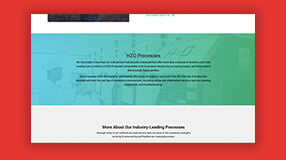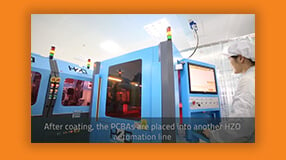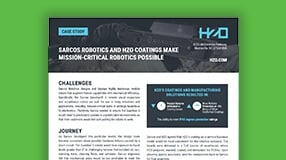Volume Resistivity - Definition, Measurement, Product Design

Whether designing circuit boards or protecting electrical components, knowledge of the volume resistivity of coating materials plays a pivotal role in creating efficient and reliable electronic products. This critical measurement refers to the ability of a material to resist the flow of electric current within its volume. In other words, it measures how well a substance conducts or insulates electricity.
Defining Volume Resistivity
Volume resistivity refers to a material's resistance per unit volume when an electric field is applied. It is measured in ohm-meters (Ω·m) and depends on the material's nature and composition.
One way to understand this property is by comparing it to electrical conductivity. While volume resistivity measures the resistance to the flow of current, electrical conductivity measures how easily current flows through a material. In other words, it is the inverse of electrical conductivity. Volume resistivity is especially important in coating materials used for electrical insulation. Insulating materials like polymers or ceramics need high values to prevent electrical current leakage and ensure the circuit's integrity.
Measurement
Due to its importance, the accurate measurement of volume resistivity is essential to understanding the electrical conductivity of materials. By determining how well a coating material can resist the flow of electric current, engineers can assess its suitability for a wide range of applications.
Several techniques are common. One such method is the four-point probe technique, which involves passing a known current through a material and measuring the voltage drop across four evenly spaced points. This method enables precise calculations of the material's resistivity. Another popular technique is the two-point method. This approach passes a current through the material using two electrodes, and the voltage drop is measured. By applying Ohm's Law, the resistivity can be easily determined.
Specialized equipment is necessary to measure this value. This equipment includes multimeters, which can accurately measure voltage and current. Custom-built setups are often employed for specific applications to ensure precise measurement results.
Influencing Factors
Various factors can influence the volume resistivity of a coating material. These factors can alter the resistance properties of a material and potentially affect its performance in electrical applications. They include the following:
- Material composition - the composition of a material plays a crucial role in determining its volume resistivity. Different materials have different electrical properties, which can significantly influence their resistance to electric current flow.
- Molecular structure - materials with tightly packed and well-ordered molecular structures tend to have higher resistivity as the movement of free electrons is restricted.
- Impurities - even small amounts of impurities can disrupt the movement of electrons, leading to changes in the coating material's electrical resistance.
Relationship Between Coating Materials and Volume Resistivity
Polymer materials have different volume resistivity values, determining their ability to conduct or resist electrical current. The volume resistivity of a polymer is directly influenced by its molecular structure and composition. Some examples of polymer materials with high values include polyethylene and polypropylene. These materials are commonly used in cable insulation and high voltage applications, where electrical current needs to be contained. On the other hand, polymer materials with low values, such as conductive polymers and carbon-filled composites, are often used as electrical conductors. They are suitable for applications requiring efficient electrical current flow.
Why is This Property Important for Product Design?
Volume resistivity is a critical value that helps determine the suitability of coating material for specific applications. Engineers can select the most appropriate materials to ensure optimal performance and safety by knowing how conductive or insulating a substance is. Additionally, understanding this property helps diagnose and prevent electrical failures in electronic products. Analyzing the volume resistivity of protective coating material within an electrical system allows potential issues, such as short circuits or unexpected voltage drops, to be identified and rectified before they cause significant damage or failures. This proactive approach saves time and money while enhancing the system's reliability. Last, volume resistivity is essential in complying with industry standards and regulations. Many sectors, including electronics, automotive, and aerospace, have stringent requirements for electrical systems. By ensuring that materials used in these systems possess the appropriate volume resistivity values, businesses can meet these standards and ensure the longevity of their products.
Significance in Circuit Design
In circuit design, selecting coating materials with appropriate volume resistivity is paramount. This property plays a significant role in ensuring electronic devices' proper functioning and performance. By selecting materials with appropriate volume resistivity, circuit designers can ensure the proper operation of different components, minimize the risk of electrical failures, and enhance the overall functionality of the circuit.
Overall, this is a critical factor to consider during circuit design. It not only influences the performance and efficiency of electronic devices but also allows for the optimization of circuit design by selecting materials based on their electrical properties. If you are searching for a protective coating with volume resistivity that meets the criteria for your application, please contact us; we may be able to help. For more information about the critical electrical properties of coating materials, please visit our coating properties page.
What is Coefficient of Linear Expansion? Formula, Units & More
Elongation at Break - Definition, Testing, Material Selection
HZO Celebrates Pi Day 2025
Mallory is a veteran writer with over a decade of writing experience and has spent over five years at HZO learning about coating technology from the best minds in the industry. Professionally, Mallory is especially interested in the process of problem-solving and watching how the engineering team develops solutions that ensure business requirements are met. Over her years at HZO, Mallory's writing has been cited in industry whitepapers, including "Parabolic Model for Optimum Dry Film Thickness (DFT) of Corrosion Protective Coatings" and "Universal Approach to Integrating Reduced Graphene Oxide into Polymer Electronics." All of Mallory’s blogs are reviewed for accuracy before publication.
Additional Resources

Learn About HZO's Partnership With a Fortune 100 Consumer Electronics Company















